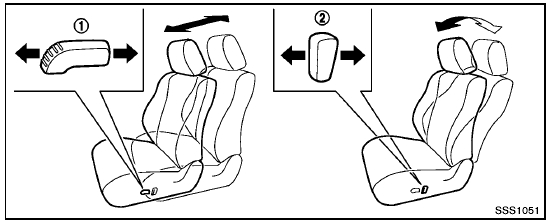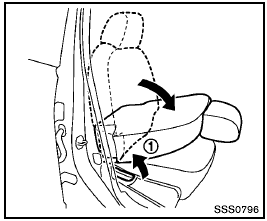Seats

Seats

- Do not ride in a moving vehicle when the seatback is reclined. This can be dangerous. The shoulder belt will not be against your body. In an accident, you could be thrown into it and receive neck or other serious injuries. You could also slide under the lap belt and receive serious internal injuries.
- For the most effective protection when the vehicle is in motion, the seat should be upright. Always sit well back in the seat with both feet on the floor and adjust the seat properly. See “Precautions on seat belt usage” later in this section.
- After adjustment, gently rock in the seat to make sure it is securely locked.
- Do not leave children unattended inside the vehicle. They could unknowingly activate switches or controls.
Unattended children could become involved in serious accidents.
- The seatback should not be reclined any more than needed for comfort.
Seat belts are most effective when the passenger sits well back and straight up in the seat. If the seatback is reclined, the risk of sliding under the lap belt and being injured is increased.

When adjusting the seat positions, be sure not to contact any moving parts to avoid possible injuries and/or damages.
Front seats

Front manual seat adjustment
Forward and backward:
Pull the lever 1 up and hold it while you slide the seat forward or backward to the desired position. Release the lever to lock the seat in position.
Reclining:
To recline the seatback, pull the lever 2 up and lean back. To bring the seatback forward, pull the lever up and lean your body forward. Release the lever to lock the seatback in position.
The reclining feature allows adjustment of the seatback for occupants of different sizes for added comfort and to help obtain proper seat belt fit. (See “Precautions on seat belt usage” later in this section.) Also, the seatback can be reclined to allow occupants to rest when the vehicle is stopped and the transmission in the P (Park) position with the parking brake fully applied.

Seat lifter (if so equipped):
Pull up or push down the adjusting lever to adjust the seat height until the desired position is achieved.
Front power seat adjustment
Operating tips:
- The seat motor has an auto-reset overload protection circuit. If the motor stops during operation, wait for a while, then reactivate the switch.
- Do not operate the power seat for a long period of time when the engine is off. This will discharge the battery.

Forward and backward:
Moving the switch 1 forward or backward will slide the seat forward or backward to the desired position.
Reclining:
Move the recline switch 2 backward until the desired angle is obtained. To bring the seatback forward again, move the switch 2 forward.
The reclining feature allows adjustment of the seatback for occupants of different sizes for added comfort and to help obtain proper seat belt fit. (See “Precautions on seat belt usage” later in this section.) Also, the seatback can be reclined to allow occupants to rest when the vehicle is stopped and the transmission in the P (Park) position with the parking brake fully applied.

Seat lifter (if so equipped):
Pull up or push down the adjusting switch to adjust the height of the seat.

Lumbar support (if so equipped):
The lumbar support feature provides lower back support to the driver.
Push the front or back end of the switch to adjust the seat lumbar area.
Folding front passenger’s seat (if so equipped)

Folding front passenger’s seat (if so equipped)
The front passenger’s seatback can be folded down. Some long objects may be loaded in the vehicle when the rear seats are also folded down. (See “Rear seats” later in this section for folding rear seats.) To fold the front passenger’s seatback, pull the reclining lever all the way 1 .
When returning the front passenger’s seatback to a seating position, lift it up to an upright position. Pull the reclining lever and lean the seatback to a proper seating position. (See “Front manual seat adjustment” earlier in this section.)

- If you fold the front passenger’s seatback down to carry longer objects, be sure this cargo is properly secured and not near an air bag. In a crash, an inflating air bag might force that object toward a person.
This could cause severe injury or even death. Secure objects away from the area in which an air bag would inflate. See “Precautions on Supplemental Restraint System” later in this section.
- Never allow anyone to ride in the cargo area or on the front passenger’s seat when it is in the folddown position. Use of these areas by passengers could result in serious injury in an accident or sudden stop.
Rear seats

Folding
Before folding the rear seats:
- Secure the seat belts on the seat belt hooks on the side wall. (See “Seat belt hooks” later in this section.) - Release the connector tongue of the rear center seat belt from the buckle, and store the connector and seat belt tongues into the retractor base on the ceiling. (See “Rear center seat belt” later in this section.) - If necessary, move the front seats forward to provide enough clearance so that the rear seats can be folded down completely.
To fold down the seatback of each rear seat, pull the adjusting knob A .
To return the seatback to the seating position, lift up each seatback and push it to the upright position until it is latched.

- Do not use the rear seat belts when the buckles are stowed in the seat pockets. Failure to do so may reduce the effectiveness of the entire restraint system and increase the chance or severity of injury in an accident.
- Do not fold down the rear seats when occupants are in the rear seat area or any objects are on the rear seats.
- Never allow anyone to ride in the cargo area or on the rear seats when they are in the fold-down position. Use of these areas by passengers without proper restraints could result in serious injury in an accident or sudden stop.
- Properly secure all cargo with ropes or straps to help prevent it from sliding or shifting. Do not place cargo higher than the seatbacks. In a sudden stop or collision, unsecured cargo could cause personal injury.
- When returning the seatbacks to the upright position, be certain they are completely secured in the latched position. If they are not completely secured, passengers may be injured in an accident or sudden stop.
Head restraints

Head restraints supplement the other vehicle safety systems. They may provide additional protection against injury in certain rear end collisions. Adjust the head restraints properly, as specified in this section. Check the adjustment after someone else uses the seat. Do not attach anything to the head restraint stalks or remove the head restraint. Do not use the seat if the head restraint has been removed. If the head restraint was removed, install and properly adjust the head restraint before an occu- pant uses the seating position. Failure to follow these instructions can reduce the effectiveness of the head restraints.
This may increase the risk of serious injury or death in a collision.

The illustration shows the seating positions equipped with head restraints. The head restraints are adjustable.
 Indicates the seating position is
equipped with a head restraint.
Indicates the seating position is
equipped with a head restraint.

Components
1. Head restraint
2. Adjustment notches
3. Lock knob
4. Stalks

Adjustment
Adjust the head restraint so the center is level with the center of your ears.

To raise the head restraint, pull it up.

To lower, push and hold the lock knob and push the head restraint down.

Removal
Use the following procedure to remove the adjustable head restraints.
1. Pull the head restraint up to the highest position.
2. Push and hold the lock knob.
3. Remove the head restraint from the seat.
4. Store the head restraint properly in a secure place so it is not loose in the vehicle.
5. Install and properly adjust the head restraint before an occupant uses the seating position.

Install
1. Align the head restraint stalks with the holes in the seat. Make sure that the head restraint is facing the correct direction. The stalk with the adjustment notches 1 must be installed in the hole with the lock knob 2 .
2. Push and hold the lock knob and push the head restraint down.
3. Properly adjust the head restraint before an occupant uses the seating position.

Front-seat Active Head Restraints
The Active Head Restraint moves forward utilizing the force that the seatback receives from the occupant in a rear-end collision. The movement of the head restraint helps support the occupant’s head by reducing its backward movement and helping absorb some of the forces that may lead to whiplash-type injuries.
Active Head Restraints are effective for collisions at low to medium speeds in which it is said that whiplash injury occurs most.
Active Head Restraints operate only in certain rear-end collisions. After the collision, the head restraints return to their original position.
Adjust the Active Head Restraints properly as described earlier in this section.
See also:
Vents
Adjust air flow direction for the driver’s and passenger’s
side vents 1 , center vents 2 , and rear
vents 3 by moving the vent slide and/or vent
assemblies.
Open or close the vents using t ...
Sonar system (if so equipped)
- The sonar system is a convenience but it is not a substitute for proper
parking. Always look around and check that it is safe to do so before parking. Always
move slowly.
- Read and underst ...
Meters and gauges
1. Tachometer
2. Warning/indicator lights
3. Vehicle Information Display
4. Speedometer
5. Fuel gauge
6. Odometer/Twin trip odometer
7. Engine coolant temperature gauge ...
